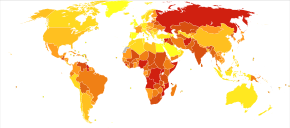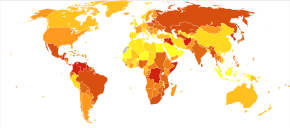Injury
Definition
| Injury | |
|---|---|
 | |
| The knee of a person is examined with the help of radiography after an injury. | |
| Specialty | Emergency medicine, Traumatology |
Injury, also known as physical trauma, is damage to the body caused by external force. This may be caused by accidents, falls, hits, weapons, and other causes. Major trauma is injury that has the potential to cause prolonged disability or death.
In 2013, 4.8 million people died from injuries, up from 4.3 million in 1990. More than 30% of these deaths were transport-related injuries. In 2013, 367,000 children under the age of five died from injuries, down from 766,000 in 1990. Injuries are the cause of 9% of all deaths, and are the sixth-leading cause of death in the world.
Classification
The World Health Organization (WHO) developed the International Classification of External Causes of Injury (ICECI). Under this system, injuries are classified by:
- mechanism of injury;
- objects/substances producing injury;
- place of occurrence;
- activity when injured;
- the role of human intent;
and additional modules. These codes allow the identification of distributions of injuries in specific populations and case identification for more detailed research on causes and preventive efforts.
The United States Bureau of Labor Statistics developed the Occupational Injury and Illness Classification System (OIICS). Under this system injuries are classified by
- nature,
- part of body affected,
- source and secondary source, and
- event or exposure.
The OIICS was first published in 1992 and has been updated several times since.
The Orchard Sports Injury Classification System (OSICS) is used to classify injuries to enable research into specific sports injuries.
By cause
- Intentional injury
- Suicide and self-harm
- Violence and war
- Accidents
- Stingray injury
- Lightning injuries
By modality
- Traumatic injury, a body wound or shock produced by sudden physical collision or movement
- Avulsion injury
- Blast injury
- Bone fracture
- Internal bleeding
- Crush injury
- Needlestick injury
- Catastrophic injury
- Repetitive strain injury or other strain injury
- Other injuries from external physical causes, such as radiation poisoning, burn, or frostbite
- Radiation-induced lung injury
- Microwave burn
- Injury from toxin or as adverse effect of a pharmaceutical drug
- Toxic injury
- Injury from internal causes such as reperfusion injury
By location
- Wound, an injury in which skin is torn, cut or punctured (an open wound), or where blunt force trauma causes a contusion (a closed wound). In pathology, it specifically refers to a sharp injury which damages the dermis of the skin.
- Brain injury
- Acquired brain injury
- Coup contrecoup injury
- Diffuse axonal injury
- Frontal lobe injury
- Nerve injury
- Spinal cord injury
- Brachial plexus injury
- Peripheral nerve injury
- Sciatic nerve injury
- Injury of axillary nerve
- Soft tissue injury
- Penile strangulation
- Cell damage, including direct DNA damage
- Lisfranc injury
- Tracheobronchial injury
- Eye injury
- Chemical eye injury
- Eye injuries during general anaesthesia
- Acute kidney injury
- Knee injury
- Anterior cruciate ligament injury
- Medial knee injuries
- Back injury
- Hand injury
- Liver injury
- Head injury
- Penetrating head injury
- Closed head injury
- Musculoskeletal injury
- Articular cartilage injuries
- Acute lung injury
- Pancreatic injury
- Thoracic aorta injury
- Biliary injury
- Chest injury
- Asphyxia
By activity
- Reverse bite injury
- Lead climbing injuries
- Occupational injury
- Ventilator-associated lung injury
- Sea urchin injury
- Transfusion-related acute lung injury
- Illness and injuries during spaceflight
Injury severity score
The injury severity score (ISS) is a medical score to assess trauma severity. It correlates with mortality, morbidity, and hospitalization time after trauma. It is used to define the term major trauma (polytrauma), recognized when the ISS is greater than 15. The AIS Committee of the Association for the Advancement of Automotive Medicine designed and updates the scale.
Text is available under the Creative Commons Attribution-ShareAlike License

